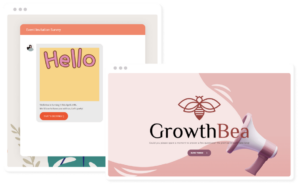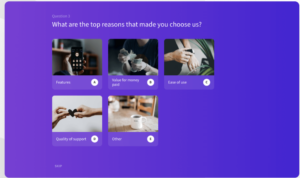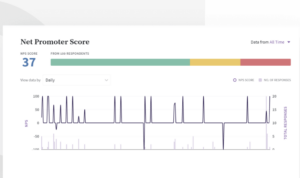What Is Customer Experience Management & Why It Matters

Kate Williams
Last Updated: 25 November 2024
14 min read

Investing in customer experience management is always a great idea. To implement it well, though, you need to be able to measure returns on your customer experience strategy.
Otherwise, your money might be used up in initiatives that don’t improve CX and instead just drain resources. Identifying such potholes is key to a good customer experience.
You might ask, “How do you measure returns on customer experience?” At first glance, it might seem impossible to measure if specific initiatives are helping make your customers happier.
However measuring returns on customer experience is not that difficult. You just need to know where to look. To help you out, we will:
- Learn the definition of customer experience management (CEM)
- List out all the ways to measure returns on CX
What is Customer Experience Management?
Customer experience (CX) is an umbrella term for how your customer perceives your brand after interacting with it during the customer life cycle. In simple words, it’s what customers think of how you treat them. No wonder it’s an area business often focuses on improving.
Customer experience management (CEM/CXM) is, by extension, how you manage your customer journey when they interact with your brand. It involves knowing your customers’ needs deeply and designing a customer experience strategy to fit those needs.
Knowing your customers is, after all, the first step to an effective customer experience strategy. A well-managed customer experience involves active oversight of all aspects of your customer journey, including ROI.
But how do you measure returns on customer experience? Here are a few ways to find out if your CXM initiatives and strategies are working.
CXM vs. CRM: What’s the Difference?
CXM (Customer Experience Management) and CRM (Customer Relationship Management) both play pivotal roles in customer-centric business models but have different focuses:
CRM (Customer Relationship Management):
- Primary Focus: Manages interactions with current and potential customers, emphasizing sales, service, and marketing processes.
- Key Features: Tracks sales leads, monitors customer interactions, manages contact information, and analyzes sales data.
- Objective: Streamline and improve business relationships to increase sales and customer retention.
CXM (Customer Experience Management):
- Primary Focus: Oversees the entirety of a customer’s journey and interactions with a brand, aiming to enhance overall satisfaction.
- Key Features: Gathers feedback across touchpoints, analyzes customer behavior, and refines interactions to improve the customer journey.
- Objective: Create positive, holistic customer experiences to boost loyalty and advocacy.
In essence, while CRM focuses on managing relationships, CXM emphasizes enhancing the overall customer experience.
Why is Customer Experience Management Important?
Imagine walking into your favorite café. What makes you go back? Is it just the coffee, or how they greet you, the cozy ambiance, the speedy service? That entire vibe is ‘customer experience.’ Customer Experience Management, or CEM, is all about creating consistently great vibes for every customer, every time.
It’s important because when customers feel valued and enjoy the whole experience, not just the product, they’re more likely to come back, tell their friends, and become loyal fans. In a world filled with choices, a stellar experience can decide what sets one business apart.
5 Steps to Build an Effective Customer Experience Strategy
Building an effective customer experience strategy is essential for businesses today. Here’s a simplified 5-step guide:
1. Understand Your Customers:
- Profile and Segment: Break down your customer base into segments to tailor experiences effectively.
- Journey Mapping: Outline customers’ touchpoints and interactions with your brand, highlighting potential pain points.
2. Set Clear Objectives:
- Vision Setting: Define what kind of experience you want to deliver.
- KPIs: Establish measurable goals, like Net Promoter Score (NPS) or Customer Satisfaction (CSAT).
3. Gather Continuous Feedback:
- Surveys: Use tools like post-interaction surveys to gauge satisfaction.
- Active Listening: Monitor social media and review sites to understand customer sentiments.
Sign up now and explore SurveySparrow’s customer pulse surveys
14-day free trial • Cancel Anytime • No Credit Card Required • No Strings Attached
4. Implement and Iterate:
- Actionable Insights: Use feedback to identify areas of improvement.
- Test and Learn: Experiment with different strategies, assess their impact, and refine them based on results.
5. Empower Employees:
- Training: Provide regular training on the importance of customer experience.
- Feedback Loop: Ensure employees have a channel to voice customer feedback and concerns.
Why is SurveySparrow the Best Customer Experience Management Tool
SurveySparrow has emerged as a standout in the field of Customer Experience Management (CEM) tools, and here’s why many consider it among the best:
1. User-Friendly Interface:
- SurveySparrow’s design is intuitive, making it easy for both beginners and seasoned professionals to craft and distribute surveys.
2. Conversational Surveys:
- Unlike traditional forms, SurveySparrow offers a chat-like experience, making it more engaging for respondents.
3. Omnichannel Distribution:
- Whether it’s via email, web links, social media, or embedded on a website, SurveySparrow ensures your survey reaches the audience wherever they are.

4. Comprehensive Reporting:
- With real-time analytics, you can derive actionable insights quickly. Their dashboard offers various data visualization options, helping businesses make informed decisions.
5. Integration Capabilities:
- SurveySparrow seamlessly integrates with popular CRM, marketing, and sales tools, ensuring a smooth flow of data and automated processes.
6. Scalability:
- Whether you’re a startup or a large enterprise, SurveySparrow can handle your needs, scaling as your business grows.
7. Feedback Automation:
- Automate the feedback collection process with recurring surveys, ensuring you continuously gather and act on customer insights.
8. Custom Branding:
- Maintain brand consistency by customizing surveys to match your company’s look and feel.
In summary, SurveySparrow’s blend of functionality, user-friendliness, and flexibility makes it a compelling choice for businesses prioritizing customer experience. However, while it has its strengths, evaluating whether it aligns with specific organizational needs and preferences is essential.
Sign up and explore the most trusted customer experience management software in the industry.
14-day free trial • Cancel Anytime • No Credit Card Required • No Strings Attached
How to Measure Returns on Customer Experience Management?
Measuring returns on CX initiatives can be tricky, but it’s not as hard as it might seem. There are a few places you can look to find out if your customer experience strategy is working. Here, we will walk through the numerous ways you can measure returns on customer experience.
A. Find Metrics Impacted by the Customer Experience Strategy
One of the key methods for finding returns on customer experience is to look at the numbers they affect. Your business has this data already. This step just involves repurposing it to give us new information.
We’ve listed a few metrics below that can help you find out if your customer experience has improved.
1. Customer Satisfaction Data
A lot of businesses happily function under the myth that customer satisfaction is not quantifiable. But the time to treat customer satisfaction like a magical, unmeasurable entity is behind us. A spike in customer satisfaction is a direct result of good customer experience management.
Measuring customer satisfaction is not very hard. Businesses do it all the time when they ask you to review a product or their service. Some organizations even send Net Promoter Score (NPS) surveys.
With a powerful online survey tool like SurveySparrow, you can easily measure customer satisfaction at all key touchpoints through pop-ups, kiosks, embeds, emails, QR codes and more. They will be embedded seamlessly in your customer journey. Here’s a quick customer satisfaction survey created using SurveySparrow.
You can build similar surveys with a free account. Sign up to start creating yours.
14-day free trial • Cancel Anytime • No Credit Card Required • No Strings Attached
Customer satisfaction is not a magical, unquantifiable thing. Realizing that and collecting customer satisfaction data will help you show the direct returns on your customer experience management efforts.
2. Revenues
This may sound too obvious, but you don’t want to miss the insights hidden in plain sight.
Improving customer experience has been shown to impact top-line revenue greatly. If your revenue has seen an increase with no other factors involved, it’s worth investigating if that was due to better CX.
The link between CX and revenue is well established. A Forrester study recently found that improving customer experience by just one point led to a billion dollars in added revenue for some industries. An increase in revenue a very strong indicator that your customer experience management is working.
When looking into revenue data, eliminate factors such as reduced costs and only factor in the revenue generated by sales. Then you know you’re looking at the customer-facing aspect of payments. An increase in sales is the best case you could make for investing more in customer experience management.
2. Customer Retention Data
Customer retention statistics are heavily impacted by customer experience. And when it comes to ROI on customer experience, your customer retention data can speak volumes.
In a data-driven world, businesses are increasingly able to track their repeat customers. If you’re looking at high customer retention, that’s a strong indicator that customers are actively choosing your brand repeatedly.
An improvement in customer experience can often result in customers being more loyal to your brand. After all, who doesn’t like to be treated well? On the other hand, low customer retention might mean your customer experience strategy needs some changes.
Related: How to create a customer retention program that’s right for you
4. Customer Service Costs
You may think that customer service is a necessary cost that you have to bear, and there’s nothing you can do to change it. Except, there is. Customer service is a result of customers not being satisfied. Businesses that have poor CX have to compensate with more customer service resources.
Customer service is where customers register complaints about your service. If you improve your customer experience to cover those bases, they won’t have to complain. A reduction in customer service requests indicates that your customer experience management is on point.
When designing a customer experience strategy, it can also be helpful to talk to your customer service representatives. What are customers’ most frequent complaints? Customer service can give you the entire roadmap to better customer experience management.
5. Upsell Data
When a customer is happy with a brand, they tend to trust it across the board. That’s why brands with high customer loyalty often see the same customers buying multiple products or services from them. It’s an indicator that your customer experience management is on point.
When you focus on improving customer experience, then customers start to rely on you more for their needs. That’s how CXM promotes upsell. Because of this, looking at your upsell data can be useful to find returns on your customer experience.
If your average transactions per customer have gone up, better customer experience management is a very likely cause. On the other hand, if customers are buying less from your brand, you might need to investigate if something is wrong with your customer journey. Either way, upsell is a great indicator of returns on your customer experience strategy.
Related: What an ex-rockbander can teach us about rockstar CX
B. Conduct Customer Surveys To Measure Returns on CX

Looking at metrics like sales revenue and upsell is one way to go. It uses existing data to create new insights, but that can only go so far. If you want to measure returns on your customer experience with precision, customer surveys are the way to go.
A customer survey is the most direct and reliable way to measure returns on your customer experience initiatives. Regular customer experience surveys can help you find out if your strategies are working. They can also help identify problem areas, helping you design an effective customer experience strategy in the first place.
Here are a few different types of customer surveys that could give you valuable insights into your customer experience management.
1. Customer Satisfaction Surveys
As we mentioned above, customer satisfaction data is very useful in measuring returns on your customer experience strategy. To get that data, though, you need to conduct a customer satisfaction survey. Using SurveySparrow’s templates, you can design a professional customer survey in minutes.
A customer satisfaction survey includes different types of questions depending on your needs. What do you like most about our service? What is one feature our product is missing right now? How easy is it to navigate our store? These are valuable questions, and your customers’ responses will be tremendously valuable in framing a customer experience strategy.
When you conduct regular customer satisfaction surveys, the difference in your ratings during different time intervals is valuable. You can analyze them to measure the returns of your customer experience management.
2. Net Promoter Score (NPS) Surveys
Do you recall ever having received an e-mail that included the question: ‘How likely are you to recommend our service to a friend?’ It might ask you for a likelihood between 1 to 10. That’s your Net Promoter Score. It measures how effectively brands are able to facilitate word-of-mouth advertising.
NPS scores, of course, depend to a large extent on your customer experience management. Happy customers tend to share their appreciation of your product with their network. A high NPS score is an indicator that your customer experience strategy is working.
With SurveySparrow, you can make NPS surveys a natural extension of your customer experience, whether on a website or embedded in an email. It doesn’t take customers much time to give a rating, and you get valuable data on your brand’s CX. You can use changes in your NPS score to measure the returns on your customer experience.

3. Customer Effort Score Surveys
Like NPS, Customer Effort Score (CES) is also a rating given by customers based on their experience. While NPS measures if your customer would recommend your product, customer effort scores measure how hard an aspect of your customer experience is.
For example, a business might ask you to rate the truth of the statement that their brand ‘made it easy for you to resolve your issue.’ That’s a CES survey. It asks customers if their experience with your brand was effortless or a hassle. CES is a very important indicator of customer experience.
If you conduct regular CES surveys, you will be able to find areas in your customer experience that customers find the most painful. You can then incorporate those insights to design a better customer experience strategy. Over time, if your CES scores are getting better, you know your customer experience management is working.
Moving Towards Better Customer Experience Management
Business leaders today are well aware that the success of a company is heavily dependent on customer experience management. Happier customers improve sales and ensure a stable revenue base for your business. That is why businesses have extensive budgets to improve their CX and create loyal customers.
If all businesses worked on improving their customer experience, imagine how easy your life would become. Our hassles are frequently a result of neglected CX. Working on your customer experience is good for customers and even better for businesses.
Of course, if you are going to dedicate precious resources to your CX, you need to see returns. No good leader would invest company resources without asking for proof that it works. Well, now you know that measuring returns on customer experience management is easily possible. Like we saw in this article, you could even repurpose already available data to make your case.
We strongly recommend, though, that you conduct regular customer surveys to keep a check on your customer experience. Not only do surveys help you measure returns on CX, but they also indicate when something is going wrong. With SurveySparrow, you can now design beautiful surveys that your customers will love to fill.
If you want to be known for great customer experience management, there is no way around getting to know your customers. Design a customer experience strategy rooted in real insights, and reap the fruits of a great customer journey!

Kate Williams
Product Marketing Manager at SurveySparrow
Excels in empowering visionary companies through storytelling and strategic go-to-market planning. With extensive experience in product marketing and customer experience management, she is an accomplished author, podcast host, and mentor, sharing her expertise across diverse platforms and audiences.

Turn every feedback into a growth opportunity
14-day free trial • Cancel Anytime • No Credit Card Required • Need a Demo?




